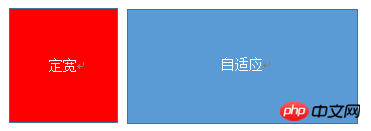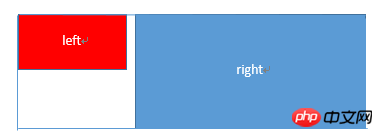Html+CSS布局技巧的代码分享
- 迷茫原创
- 2017-03-25 09:52:181488浏览
单列布局水平居中
水平居中的页面布局中最为常见的一种布局形式,多出现于标题,以及内容区域的组织形式,下面介绍四种实现水平居中的方法(注:下面各个实例中实现的是child元素的对齐操作,child元素的父容器是parent元素)
使用inline-block 和 text-align实现
.parent{text-align: center;}.child{display: inline-block;}优点:兼容性好;
不足:需要同时设置子元素和父元素
使用margin:0 auto来实现
.child{width:200px;margin:0 auto;}优点:兼容性好
缺点: 需要指定宽度
使用table实现
.child{display:table;margin:0 auto;}优点:只需要对自身进行设置
不足:IE6,7需要调整结构
使用绝对定位实现
.parent{position:relative;}/*或者实用margin-left的负值为盒子宽度的一半也可以实现,不过这样就必须知道盒子的宽度,但兼容性好*/
.child{position:absolute;left:50%;transform:translate(-50%);}不足:兼容性差,IE9及以上可用
实用flex布局实现
/*第一种方法*/.parent{display:flex;justify-content:center;}
/*第二种方法*/.parent{display:flex;}.child{margin:0 auto;}缺点:兼容性差,如果进行大面积的布局可能会影响效率
垂直居中
我们都知道,每个人都有不同的嗜好,有的人喜欢吃甜食,有的人喜欢吃辣的东西,有的人不喜欢吃芹菜,有的人不喜欢吃羊肉等等。CSS中的有些元素也是这样,他们有的只对牛奶感兴趣,有的只喜欢吃坚果和果冻,而讨厌牛奶。而vertical-align呢,是个比较挑食的家伙,它只喜欢吃果冻,从小吃果冻长大,没有了果冻,它就会闹脾气,对你不理不睬。我称之为“果冻依赖型元素”,又称之为“inline-block依赖型元素”,也就是说,只有一个元素属于inline或是inline-block(table-cell也可以理解为inline-block水平)水平,其身上的vertical-align属性才会起作用。我对css-vertical-align的一些理解与认识
在使用vertical-align的时候,由于对齐的基线是用行高的基线作为标记,故需要设置line-height或设置display:table-cell;
/*第一种方法*/.parent{display:table-cell;vertical-align:middle;height:20px;}/*第二种方法*/.parent{display:inline-block;vertical-align:middle;line-height:20px;}
实用绝对定位
.parent{position:relative;}
.child{positon:absolute;top:50%;transform:translate(0,-50%);}实用flex实现
.parent{display:flex;align-items:center;}水平垂直全部居中
利用vertical-align,text-align,inline-block实现
.parent{display:table-cell;vertical-align:middle;text-align:center;}.child{display:inline-block;}利用绝对定位实现
.parent{position:relative;}.child{position:absolute;top:50%;left:50%;transform:translate(-50%,-50%);}利用flex实现
.parent{display:flex;justify-content:center;align-items:center;}多列布局左列定宽,右列自适应
该布局方式非常常见,适用于定宽的一侧常为导航,自适应的一侧为内容的布局
利用float+margin实现
.left{float:left;width:100px;}.right{margin-left;margin-left:100px;}注:IE6会有3px的bug
利用float+margin(fix)实现

<p class="parent"> <p class="left"></p> <p class="right-fix"> <p class="right"></p> </p> </p>
.left{width:100px;float:left;}
.right-fix{width:100%;margin-left:-100px;float:right;}
.right{margin-left:100px;}使用float+overflow实现
.left{width:100px;float:left;}
.right{overflow:hidden;}overflow:hidden,触发bfc模式,浮动无法影响,隔离其他元素,IE6不支持,左侧left设置margin-left当作left与right之间的边距,右侧利用overflow:hidden 进行形成bfc模式
如果我们需要将两列设置为等高,可以用下述方法将“背景”设置为等高,其实并不是内容的等高
.left{width:100px;float:left;}
.right{overflow:hidden;}
.parent{overflow:hidden;}
.left,.right{padding-bottom:9999px;margin-bottom:-9999px;}使用table实现
.parent{display:table;table-layout:fixed;width:100%;}
.left{width:100px;}
.right,.left{display:table-cell;}实用flex实现
.parent{display:flex;}
.left{width:100px;}
.right{flex:1;}利用右侧容器的flex:1,均分了剩余的宽度,也实现了同样的效果。而align-items 默认值为stretch,故二者高度相等
右列定宽,左列自适应
实用float+margin实现
.parent{background:red;height:100px;margin:0 auto;}
.left{background:green;margin-right:-100px;width:100%;float:left;}
.right{float:right;width:100px;background:blue;}使用table实现
.parent{display:table;table-layout:fixed;width:100%;}
.left{display:table-cell;}
.right{width:100px;display:table-cell;}实用flex实现
.parent{display:flex;}
.left{flex:1;}
.right{width:100px;}两列定宽,一列自适应

基本html结构为父容器为parent,自容器为left,center,right.其中,left,center定宽,right自适应
利用float+margin实现
.left,.center{float:left:width:200px;}
.right{margin-left:400px;}利用float+overflow实现
.left,.center{float:left:width:200px;}
.right{overflow:hidden;}利用table实现
.parent{display:table;table-layout:fixed;width:100%;}
.left,.center,.right{display:table-cell;}
.left,.center{width:200px;}利用flex实现
.parent{display:flex;}
.left,.center{width:100px;}
.right{flex:1}两侧定宽,中栏自适应

利用float+margin实现
.left{width:100px;float:left;}
.center{float:left;width:100%;margin-right:-200px;}
.right{width:100px;float:right;}利用table实现
.parent{width:100%;display:table;table-layout:fixed}
.left,.center,.right{display:table-cell;}
.left{width:100px;}
.right{width:100px;}利用flex实现
.parent{display:flex;}
.left{width:100px;}
.center{flex:1;}
.right{width:100px;}一列不定宽,一列自适应

利用float+overflow实现
.left{float:left;}.right{overflow:hidden;}利用table实现
.parent{display:table;table-layout:fixed;width:100%;}
.left{width:0.1%;}
.left,.right{display:table-cell;}利用flex实现
.parent{display:flex;}
.right{flex:1;}多列等分布局
多列等分布局常出现在内容中,多数为功能的,同阶级内容的并排显示等。

html结构如下所示
<p class="parent"> <p class="column">1</p> <p class="column">1</p> <p class="column">1</p> <p class="column">1</p> </p>
实用float实现
.parent{margin-left:-20px}/*假设列之间的间距为20px*/
.column{float:left;width:25%;padding-left:20px;box-sizing:border-box;}利用table实现
.parent-fix{margin-left:-20px;}
.parent{display:table;table-layout:fixed;width:100%;}
.column{display:table-cell;padding-left:20px;}利用flex实现
.parent{display:flex;}
.column{flex:1;}
.column+.column{margin-left:20px;}九宫格布局
使用table实现
<p class="parent"> <p class="row"><p class="item"></p><p class="item"></p><p class="item"></p></p> <p class="row"><p class="item"></p><p class="item"></p><p class="item"></p></p> <p class="row"><p class="item"></p><p class="item"></p><p class="item"></p></p> </p>
.parent{display:table;table-layout:fixed;width:100%;}
.row{display:table-row;}
.item{display:table-cell;width:33.3%;height:200px;}实用flex实现
<p class="parent"><p class="row"><p class="item"></p><p class="item"></p><p class="item"></p> </p><p class="row"><p class="item"></p><p class="item"></p><p class="item"></p> </p><p class="row"><p class="item"></p><p class="item"></p><p class="item"></p></p></p>
.parent{display:flex;flex-direction:column;}
.row{height:100px;display:flex;}
.item{width:100px;background:red;}全屏布局

利用绝对定位实现
<p class="parent"><p class="top">top</p><p class="left">left</p><p class="right">right</p><p class="bottom">bottom</p></p>
html,body,parent{height:100%;overflow:hidden;}
.top{position:absolute:top:0;left:0;right:0;height:100px;}
.left{position:absolute;top:100px;left:0;bottom:50px;width:200px;}
.right{position:absolute;overflow:auto;left:200px;right:0;top:100px;bottom:50px;}
.bottom{position:absolute;left:0;right:0;bottom:0;height:50px;}利用flex实现
<p class="parent"><p class="top">top</p><p class="middle"><p class="left">left</p><p class="right">right</p></p><p class="bottom">bottom</p></p>
.parent{display:flex;flex-direction:column;}
.top{height:100px;}
.bottom{height:50px;}
.middle{flex:1;display:flex;}
.left{width:200px;}
.right{flex:1;overflow:auto;}
meta标签的实用
设置布局宽度等于设备宽度,布局viewport等于度量viewport
<meta name="viewport" content="width=device-width,initial-scale=1">
HTML 4和CSS 2目前支持为不同的媒体类型设定专有的样式表, 比如, 一个页面在屏幕上显示时使用无衬线字体,
而在打印时则使用衬线字体, screen 和 print 是两种已定义的媒体类型, 媒体查询让样式表有更强的针对性,
扩展了媒体类型的功能;媒体查询由媒体类型和一个或多个检测媒体特性的条件表达式组成,
媒体查询中可用于检测的媒体特性有width、height和color(等), 使用媒体查询, 可以在不改变页面内容的情况下,
为特定的一些输出设备定制显示效果。
语法
@media screen and (max-width:960px){....}<link rel="stylesheet" media="screen and (max-width:960px)" href='xxx.css' /以上是Html+CSS布局技巧的代码分享的详细内容。更多信息请关注PHP中文网其他相关文章!

